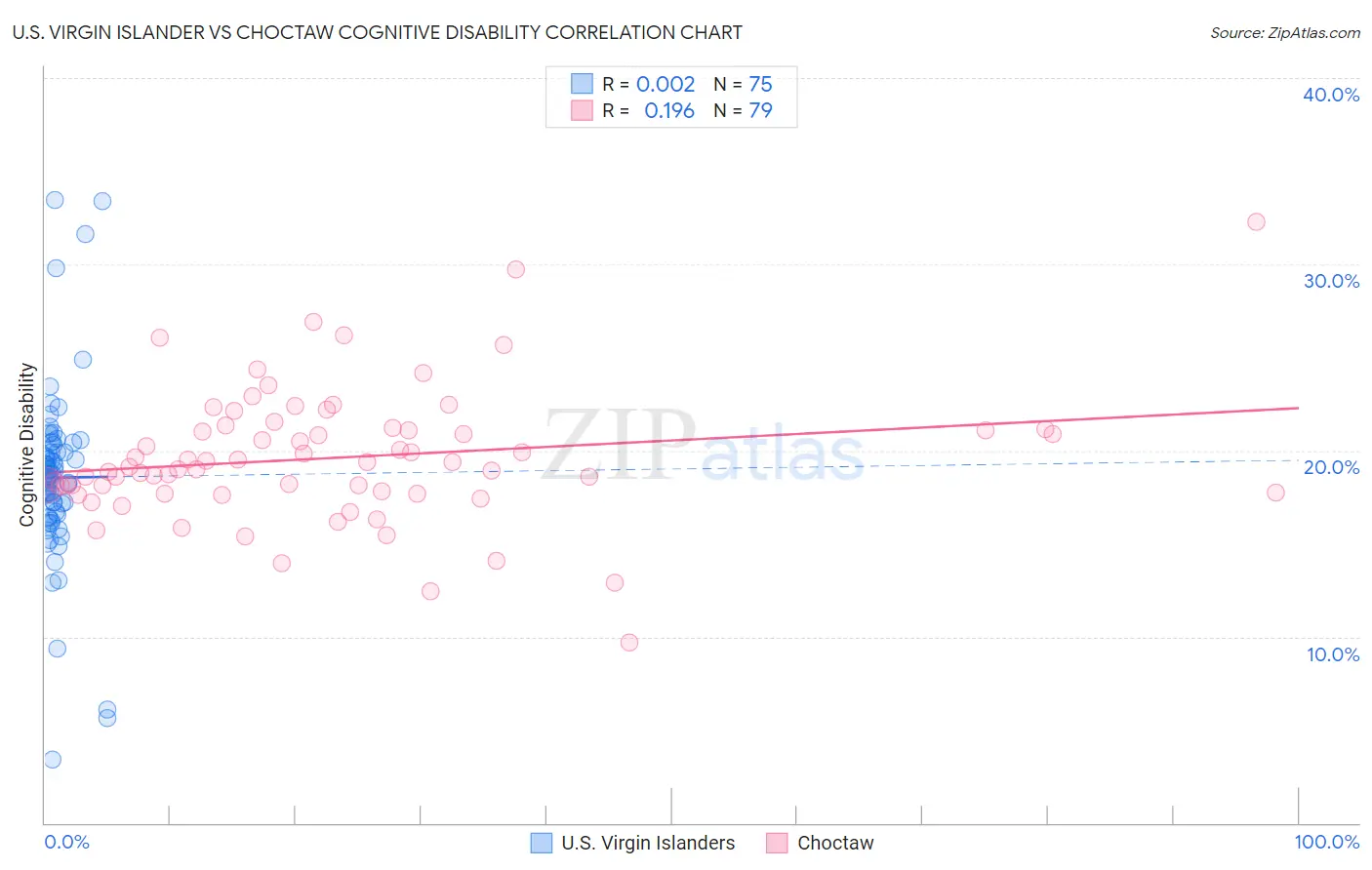U.S. Virgin Islander vs Choctaw Cognitive Disability
COMPARE
U.S. Virgin Islander
Choctaw
Cognitive Disability
Cognitive Disability Comparison
U.S. Virgin Islanders
Choctaw
18.7%
COGNITIVE DISABILITY
0.0/ 100
METRIC RATING
327th/ 347
METRIC RANK
18.4%
COGNITIVE DISABILITY
0.0/ 100
METRIC RATING
310th/ 347
METRIC RANK
U.S. Virgin Islander vs Choctaw Cognitive Disability Correlation Chart
The statistical analysis conducted on geographies consisting of 87,523,462 people shows no correlation between the proportion of U.S. Virgin Islanders and percentage of population with cognitive disability in the United States with a correlation coefficient (R) of 0.002 and weighted average of 18.7%. Similarly, the statistical analysis conducted on geographies consisting of 269,665,834 people shows a poor positive correlation between the proportion of Choctaw and percentage of population with cognitive disability in the United States with a correlation coefficient (R) of 0.196 and weighted average of 18.4%, a difference of 1.5%.

Cognitive Disability Correlation Summary
| Measurement | U.S. Virgin Islander | Choctaw |
| Minimum | 3.4% | 9.7% |
| Maximum | 33.5% | 32.3% |
| Range | 30.0% | 22.6% |
| Mean | 18.5% | 19.6% |
| Median | 18.6% | 19.1% |
| Interquartile 25% (IQ1) | 16.6% | 17.8% |
| Interquartile 75% (IQ3) | 20.3% | 21.1% |
| Interquartile Range (IQR) | 3.7% | 3.4% |
| Standard Deviation (Sample) | 4.8% | 3.6% |
| Standard Deviation (Population) | 4.8% | 3.5% |
Demographics Similar to U.S. Virgin Islanders and Choctaw by Cognitive Disability
In terms of cognitive disability, the demographic groups most similar to U.S. Virgin Islanders are Immigrants from Senegal (18.7%, a difference of 0.040%), Indonesian (18.7%, a difference of 0.060%), Kiowa (18.7%, a difference of 0.060%), Dominican (18.7%, a difference of 0.14%), and Pueblo (18.7%, a difference of 0.26%). Similarly, the demographic groups most similar to Choctaw are Hmong (18.4%, a difference of 0.030%), Chickasaw (18.5%, a difference of 0.31%), Immigrants from Eastern Africa (18.4%, a difference of 0.37%), Immigrants from Western Africa (18.4%, a difference of 0.41%), and Yaqui (18.5%, a difference of 0.42%).
| Demographics | Rating | Rank | Cognitive Disability |
| Immigrants | Western Africa | 0.0 /100 | #308 | Tragic 18.4% |
| Immigrants | Eastern Africa | 0.0 /100 | #309 | Tragic 18.4% |
| Choctaw | 0.0 /100 | #310 | Tragic 18.4% |
| Hmong | 0.0 /100 | #311 | Tragic 18.4% |
| Chickasaw | 0.0 /100 | #312 | Tragic 18.5% |
| Yaqui | 0.0 /100 | #313 | Tragic 18.5% |
| Sub-Saharan Africans | 0.0 /100 | #314 | Tragic 18.5% |
| Immigrants | Dominica | 0.0 /100 | #315 | Tragic 18.6% |
| Immigrants | Middle Africa | 0.0 /100 | #316 | Tragic 18.6% |
| Liberians | 0.0 /100 | #317 | Tragic 18.6% |
| Bangladeshis | 0.0 /100 | #318 | Tragic 18.6% |
| Comanche | 0.0 /100 | #319 | Tragic 18.6% |
| Apache | 0.0 /100 | #320 | Tragic 18.6% |
| Africans | 0.0 /100 | #321 | Tragic 18.6% |
| Immigrants | Liberia | 0.0 /100 | #322 | Tragic 18.7% |
| Pueblo | 0.0 /100 | #323 | Tragic 18.7% |
| Dominicans | 0.0 /100 | #324 | Tragic 18.7% |
| Indonesians | 0.0 /100 | #325 | Tragic 18.7% |
| Immigrants | Senegal | 0.0 /100 | #326 | Tragic 18.7% |
| U.S. Virgin Islanders | 0.0 /100 | #327 | Tragic 18.7% |
| Kiowa | 0.0 /100 | #328 | Tragic 18.7% |